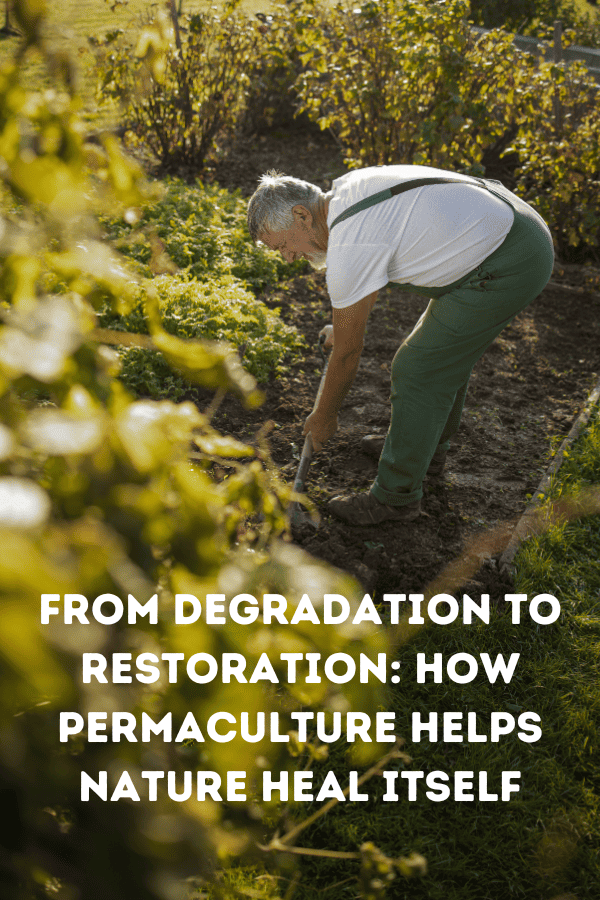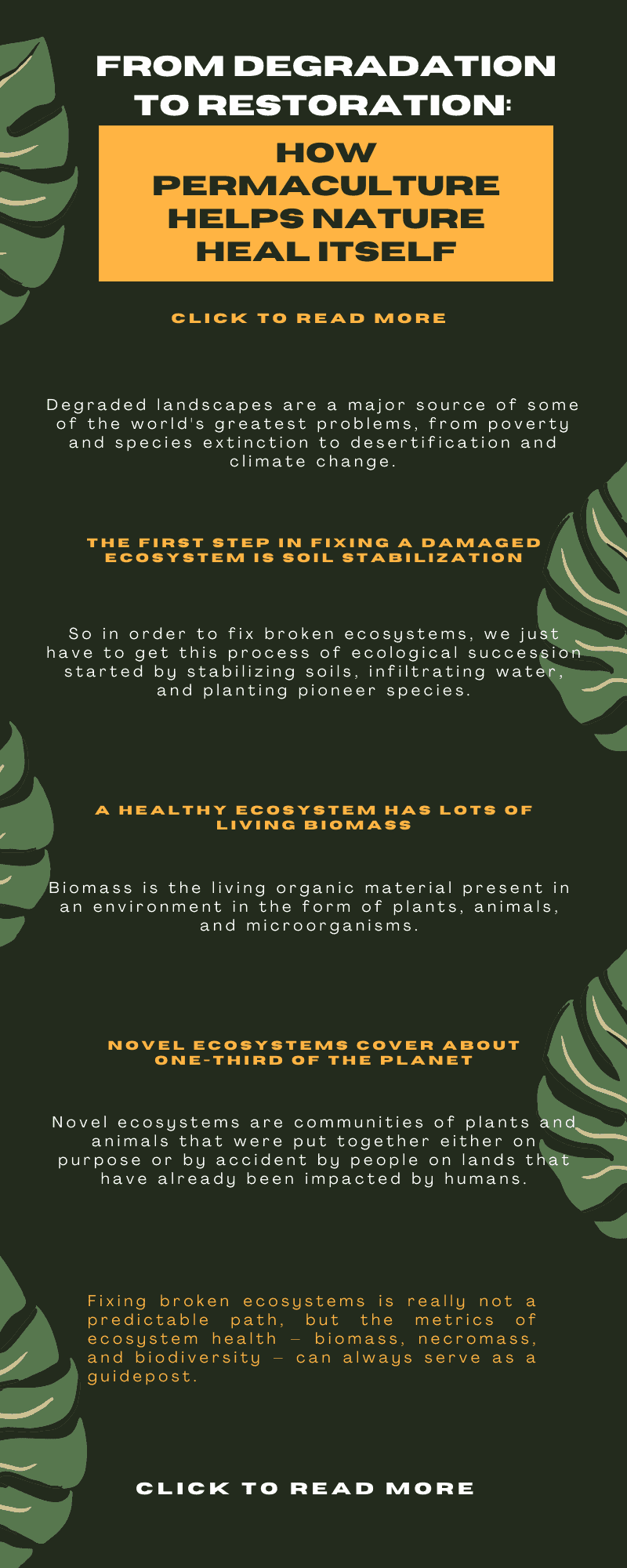
Degraded landscapes are a major source of some of the world's greatest problems, from poverty and species extinction to desertification and climate change. But the good news is that nature is incredibly resilient, and broken ecosystems can bounce back to health with just a little nudge in the right direction. In this article, we'll explore how to help nature help herself and restore degraded landscapes to health.
Building the Web of Life: A Guide to Restoring Ecosystem Health
The first step in fixing a damaged ecosystem is soil stabilization. A degraded, eroding landscape is a difficult place for life to take hold. The soil is usually compacted, topsoil is washed away, and once soil has lost its protective layer of plants and topsoil, it enters a cycle of further erosion and degradation, sometimes even washing all the way down to bedrock. So the first step in restoring a degraded landscape is to stabilize the soil. There are many different ways to do this, including creating terraces and contour swales, but the point is that when we stabilize the soil, we create the conditions for water to infiltrate. Once we get the soil relatively stable and create places for water to soak into the landscape during rains, we've created the conditions for hearty pioneer plant species to grow.
Pioneer species are really tough species of plants, cacti, lichens, fungi, and other creatures that can grow in harsh environments. To begin building the web of life, a pioneer grass or shrub seed needs to find its way into the places you've created where rain will collect and percolate. When the seed or spore or pad of the pioneer species ends up in the right spot and gets just a little bit of extra rain to start its growth, then the cycle of ecological succession can begin.
Ecological succession is like a map of the development of an ecosystem that tells us where we are and where we're headed. On one side of the scale is bare rock, and on the other side is what we call a climax community. Nature is always moving towards greater complexity. If you trigger the biological activity of a degraded landscape, then you begin this evolution where the ecosystem has greater and greater complexity until finally, it reaches a relatively stable state. What this climax community looks like is very different in different places. In the Sonoran Desert, it's an ecosystem dominated by the saguaro cactus. In the northeastern U.S., the climax forest is characterized by the sugar maple. A climax community can also be a rich grassland like what used to be the Great Plains of the United States, and where I live in Oregon, the climax community is dominated by Douglas fir or Western hemlock.
From Degradation to Restoration: How to Help Nature Heal Itself
The point is that nature is moving. You start with bare ground, and then it develops from there. In many ecosystems, the earliest plants that show up on bare ground are what most people call annual weeds. They grow, they set seed, and then they die. The crazy thing is that most of the staple crops eaten around the world by humans are annual plants just like weeds: corn, wheat, rice, for example. So most of conventional field agriculture is designed to keep the ecosystem in this early stage of ecological succession. In order to keep it here, there's continual disturbance in the form of plowing the soil, grazing it with animals, spraying herbicide, burning fields, and more. A great deal of effort is spent keeping agriculture at this stage of ecological succession. But when fields are abandoned, then the perennials start to move in: berries, shrubs, herbaceous perennials, and vines. Where I live, the exotic invasive Himalayan blackberry moves into abandoned fields and then creates a great thicket. But then, from down in that thicket, new conditions are created with all the cycling of organic matter and shade, birds eating
the berries and then spreading new seeds from their droppings, and the seeds of hearty small trees start to germinate and grow. Then those trees grow up and actually pop out above the berries and shrubs to begin to intercept the light before it hits the lower plants, creating new soil conditions with their deep roots and falling leaves and branches. So then there's more shade covering the ground, more organic material deposited, more biomass, more necromass, deeper soils, and growing biodiversity. Then the conditions are set for the next layer of trees to grow taller and collect the light until finally, a stable ecosystem is reached with a climax community until some massive disturbance comes and resets the whole scale.
Revitalizing the Planet: The Importance of Triggering Ecological Succession in Restoring Damaged Ecosystems
So in order to fix broken ecosystems, we just have to get this process of ecological succession started by stabilizing soils, infiltrating water, and planting pioneer species. But how do we even measure ecosystem health, and how do we know if we're repairing a damaged environment or not? The filmmaker and ecologist John D. Liu describes three metrics of a healthy ecosystem: biomass, necromass, and biodiversity.
Biomass is the living organic material present in an environment in the form of plants, animals, and microorganisms. A healthy ecosystem has lots of living biomass. Necromass is the amount of dead material in an environment, such as leaf litter and twigs, dead rotting wood, and the amount of carbon in the soil. A healthy ecosystem has a lot of dead material in it because necromass breaks down into organic matter in the soil, which becomes the food for soil organisms that grow more biomass. Biodiversity is the variety of different life forms present. A healthy ecosystem has lots of different species that have all kinds of interdependent relationships with each other. These species, along with their biomass and necromass, form the structure of what we call the web of life. Once that structure is in place, then the functions of a healthy ecosystem follow.
Another thing to consider is the concept of novel ecosystems. Novel ecosystems are communities of plants and animals that were put together either on purpose or by accident by people on lands that have already been impacted by humans. So they are all new assemblages of species that were never before put together in nature. At this point, novel ecosystems cover about one-third of the planet. Once you trigger ecological succession on a degraded landscape, you really don't know where the climax community will settle out. You can't know what species will be brought in by birds or mammals and begin to thrive. Fixing broken ecosystems is really not a predictable path, but the metrics of ecosystem health – biomass, necromass, and biodiversity – can always serve as a guidepost.
In conclusion, helping nature help herself is the key to restoring degraded landscapes to health. By stabilizing soil, infiltrating water, and planting pioneer species, we can trigger ecological succession and begin the process of building a web of life that is resilient and sustainable. The metrics of ecosystem health – biomass, necromass, and biodiversity – can guide us as we work to restore damaged ecosystems and protect the planet for future generations. With bold ideas like using drones to drop seed balls over vast wastelands, we can make a real difference in the health of our planet and our communities.
Embed this infographic on your site.

